Southeast University: Nestle SWOT Analysis - MGT101 Management
VerifiedAdded on 2021/06/15
|11
|2316
|60
Report
AI Summary
This report provides a comprehensive SWOT analysis of Nestlé, the world's largest food processing company. It begins with a historical overview of Nestlé's formation through the merger of Anglo-Swiss Milk Company and Henri Nestlé, highlighting its growth and expansion strategies, including acquisitions and global market penetration. The report details Nestlé's vision, mission, and objectives, emphasizing its commitment to quality, health, and sustainability. The SWOT analysis identifies Nestlé's strengths, such as its renowned brand, extensive distribution system, broad product portfolio, large workforce, and significant R&D capabilities. Weaknesses include controversies like the Maggi incident, brand structure complexities, and legal issues. Opportunities lie in healthy breakfast options, expanding markets, increasing income levels, strategic alliances, and focusing on R&D to address ethical concerns. Threats include market competition, commodity price increases, and buyer power. The report concludes with recommendations for Nestlé, including using organic raw materials, enhancing social responsibility, improving crisis management, and focusing on innovation and quality to maintain its market leadership and consumer trust. Desklib offers more solved assignments for students.
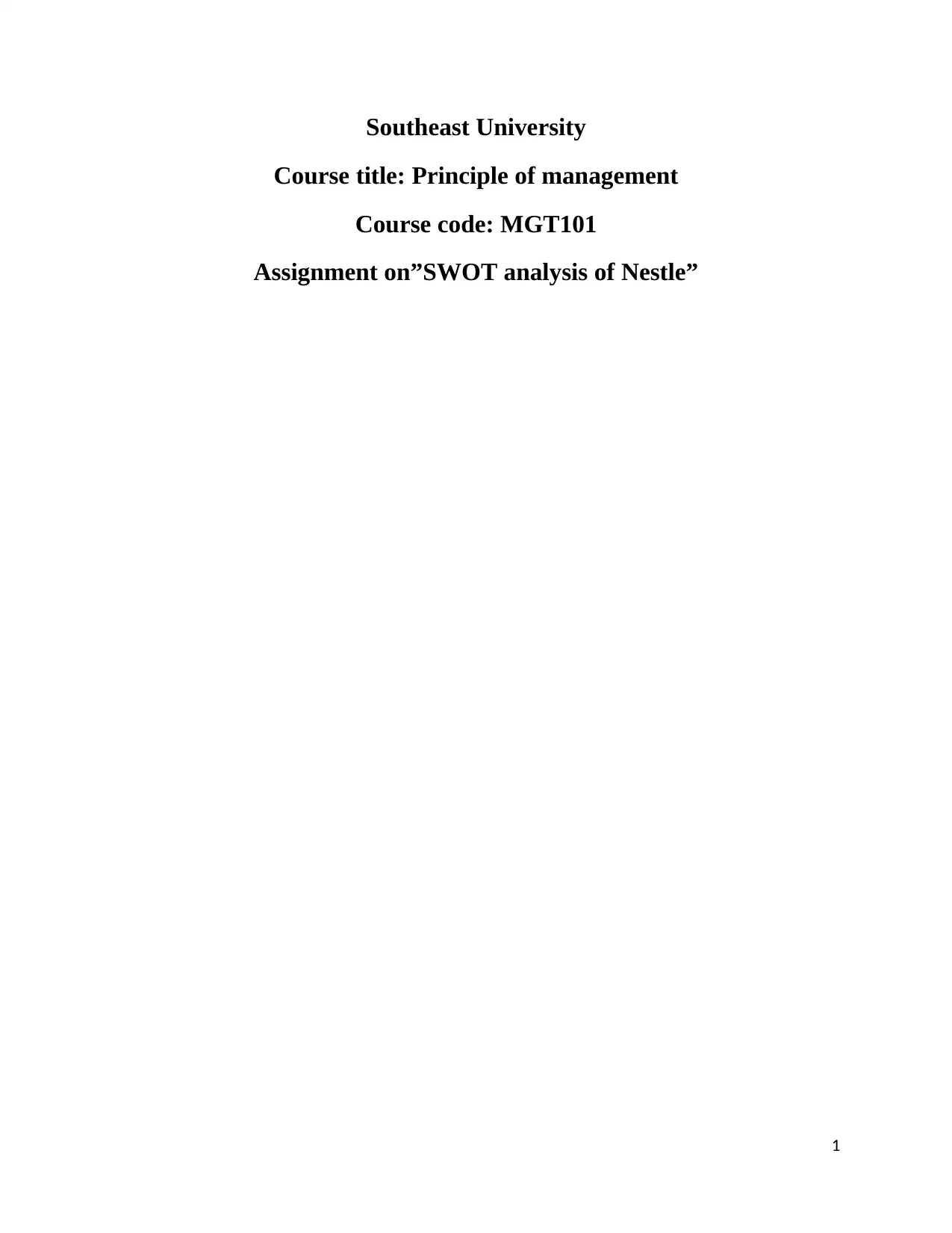
Southeast University
Course title: Principle of management
Course code: MGT101
Assignment on”SWOT analysis of Nestle”
1
Course title: Principle of management
Course code: MGT101
Assignment on”SWOT analysis of Nestle”
1
Paraphrase This Document
Need a fresh take? Get an instant paraphrase of this document with our AI Paraphraser
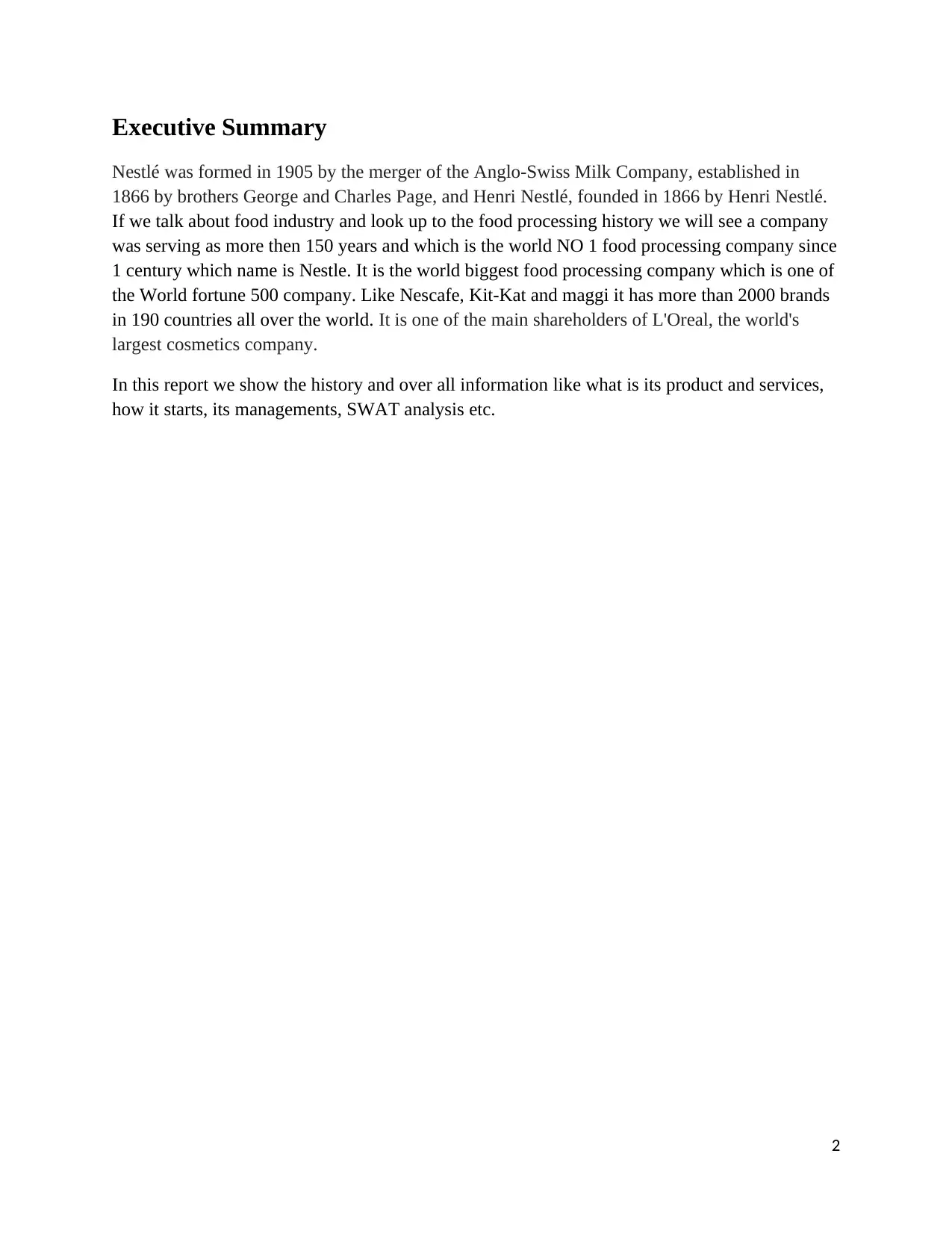
Executive Summary
Nestlé was formed in 1905 by the merger of the Anglo-Swiss Milk Company, established in
1866 by brothers George and Charles Page, and Henri Nestlé, founded in 1866 by Henri Nestlé.
If we talk about food industry and look up to the food processing history we will see a company
was serving as more then 150 years and which is the world NO 1 food processing company since
1 century which name is Nestle. It is the world biggest food processing company which is one of
the World fortune 500 company. Like Nescafe, Kit-Kat and maggi it has more than 2000 brands
in 190 countries all over the world. It is one of the main shareholders of L'Oreal, the world's
largest cosmetics company.
In this report we show the history and over all information like what is its product and services,
how it starts, its managements, SWAT analysis etc.
2
Nestlé was formed in 1905 by the merger of the Anglo-Swiss Milk Company, established in
1866 by brothers George and Charles Page, and Henri Nestlé, founded in 1866 by Henri Nestlé.
If we talk about food industry and look up to the food processing history we will see a company
was serving as more then 150 years and which is the world NO 1 food processing company since
1 century which name is Nestle. It is the world biggest food processing company which is one of
the World fortune 500 company. Like Nescafe, Kit-Kat and maggi it has more than 2000 brands
in 190 countries all over the world. It is one of the main shareholders of L'Oreal, the world's
largest cosmetics company.
In this report we show the history and over all information like what is its product and services,
how it starts, its managements, SWAT analysis etc.
2
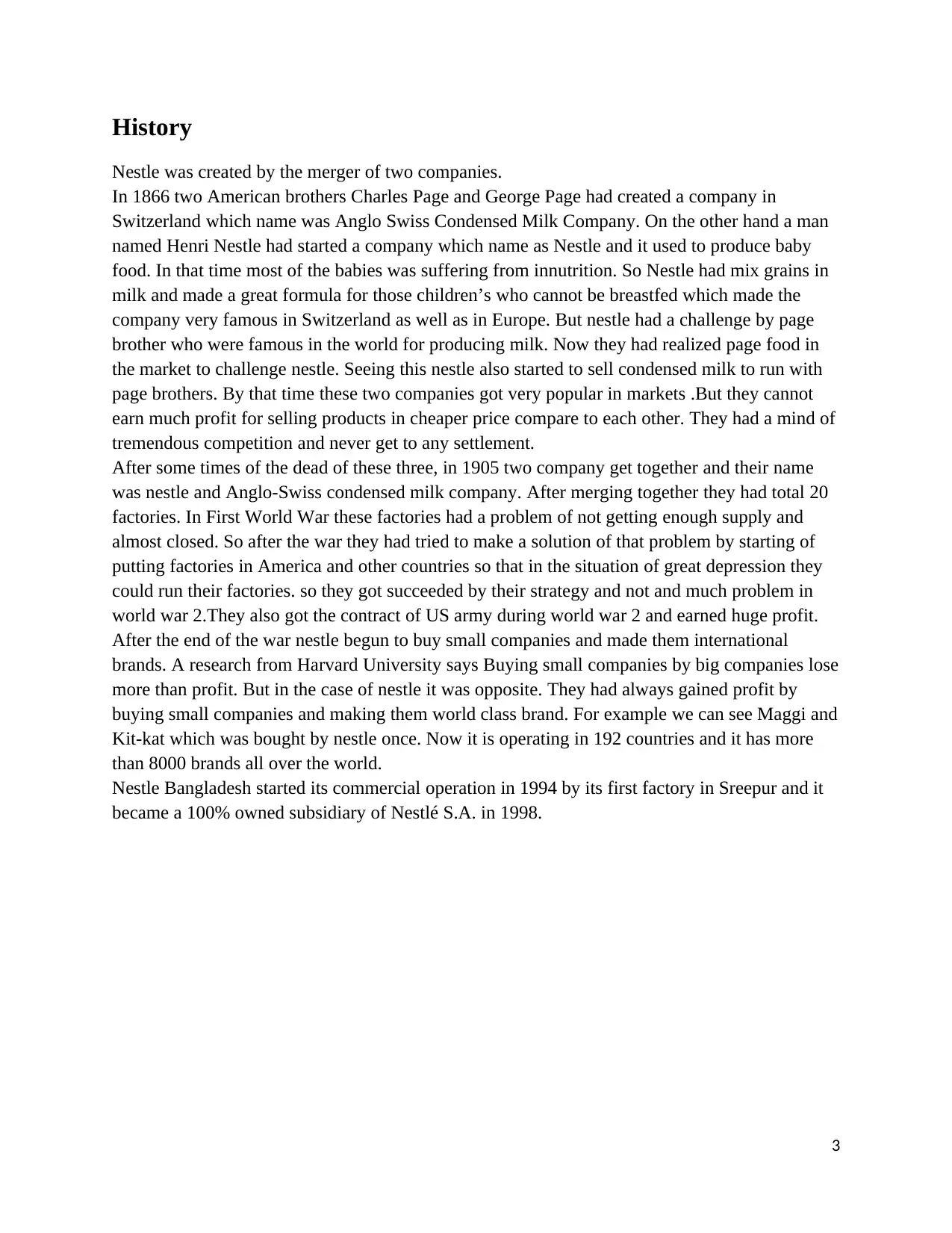
History
Nestle was created by the merger of two companies.
In 1866 two American brothers Charles Page and George Page had created a company in
Switzerland which name was Anglo Swiss Condensed Milk Company. On the other hand a man
named Henri Nestle had started a company which name as Nestle and it used to produce baby
food. In that time most of the babies was suffering from innutrition. So Nestle had mix grains in
milk and made a great formula for those children’s who cannot be breastfed which made the
company very famous in Switzerland as well as in Europe. But nestle had a challenge by page
brother who were famous in the world for producing milk. Now they had realized page food in
the market to challenge nestle. Seeing this nestle also started to sell condensed milk to run with
page brothers. By that time these two companies got very popular in markets .But they cannot
earn much profit for selling products in cheaper price compare to each other. They had a mind of
tremendous competition and never get to any settlement.
After some times of the dead of these three, in 1905 two company get together and their name
was nestle and Anglo-Swiss condensed milk company. After merging together they had total 20
factories. In First World War these factories had a problem of not getting enough supply and
almost closed. So after the war they had tried to make a solution of that problem by starting of
putting factories in America and other countries so that in the situation of great depression they
could run their factories. so they got succeeded by their strategy and not and much problem in
world war 2.They also got the contract of US army during world war 2 and earned huge profit.
After the end of the war nestle begun to buy small companies and made them international
brands. A research from Harvard University says Buying small companies by big companies lose
more than profit. But in the case of nestle it was opposite. They had always gained profit by
buying small companies and making them world class brand. For example we can see Maggi and
Kit-kat which was bought by nestle once. Now it is operating in 192 countries and it has more
than 8000 brands all over the world.
Nestle Bangladesh started its commercial operation in 1994 by its first factory in Sreepur and it
became a 100% owned subsidiary of Nestlé S.A. in 1998.
3
Nestle was created by the merger of two companies.
In 1866 two American brothers Charles Page and George Page had created a company in
Switzerland which name was Anglo Swiss Condensed Milk Company. On the other hand a man
named Henri Nestle had started a company which name as Nestle and it used to produce baby
food. In that time most of the babies was suffering from innutrition. So Nestle had mix grains in
milk and made a great formula for those children’s who cannot be breastfed which made the
company very famous in Switzerland as well as in Europe. But nestle had a challenge by page
brother who were famous in the world for producing milk. Now they had realized page food in
the market to challenge nestle. Seeing this nestle also started to sell condensed milk to run with
page brothers. By that time these two companies got very popular in markets .But they cannot
earn much profit for selling products in cheaper price compare to each other. They had a mind of
tremendous competition and never get to any settlement.
After some times of the dead of these three, in 1905 two company get together and their name
was nestle and Anglo-Swiss condensed milk company. After merging together they had total 20
factories. In First World War these factories had a problem of not getting enough supply and
almost closed. So after the war they had tried to make a solution of that problem by starting of
putting factories in America and other countries so that in the situation of great depression they
could run their factories. so they got succeeded by their strategy and not and much problem in
world war 2.They also got the contract of US army during world war 2 and earned huge profit.
After the end of the war nestle begun to buy small companies and made them international
brands. A research from Harvard University says Buying small companies by big companies lose
more than profit. But in the case of nestle it was opposite. They had always gained profit by
buying small companies and making them world class brand. For example we can see Maggi and
Kit-kat which was bought by nestle once. Now it is operating in 192 countries and it has more
than 8000 brands all over the world.
Nestle Bangladesh started its commercial operation in 1994 by its first factory in Sreepur and it
became a 100% owned subsidiary of Nestlé S.A. in 1998.
3
⊘ This is a preview!⊘
Do you want full access?
Subscribe today to unlock all pages.

Trusted by 1+ million students worldwide
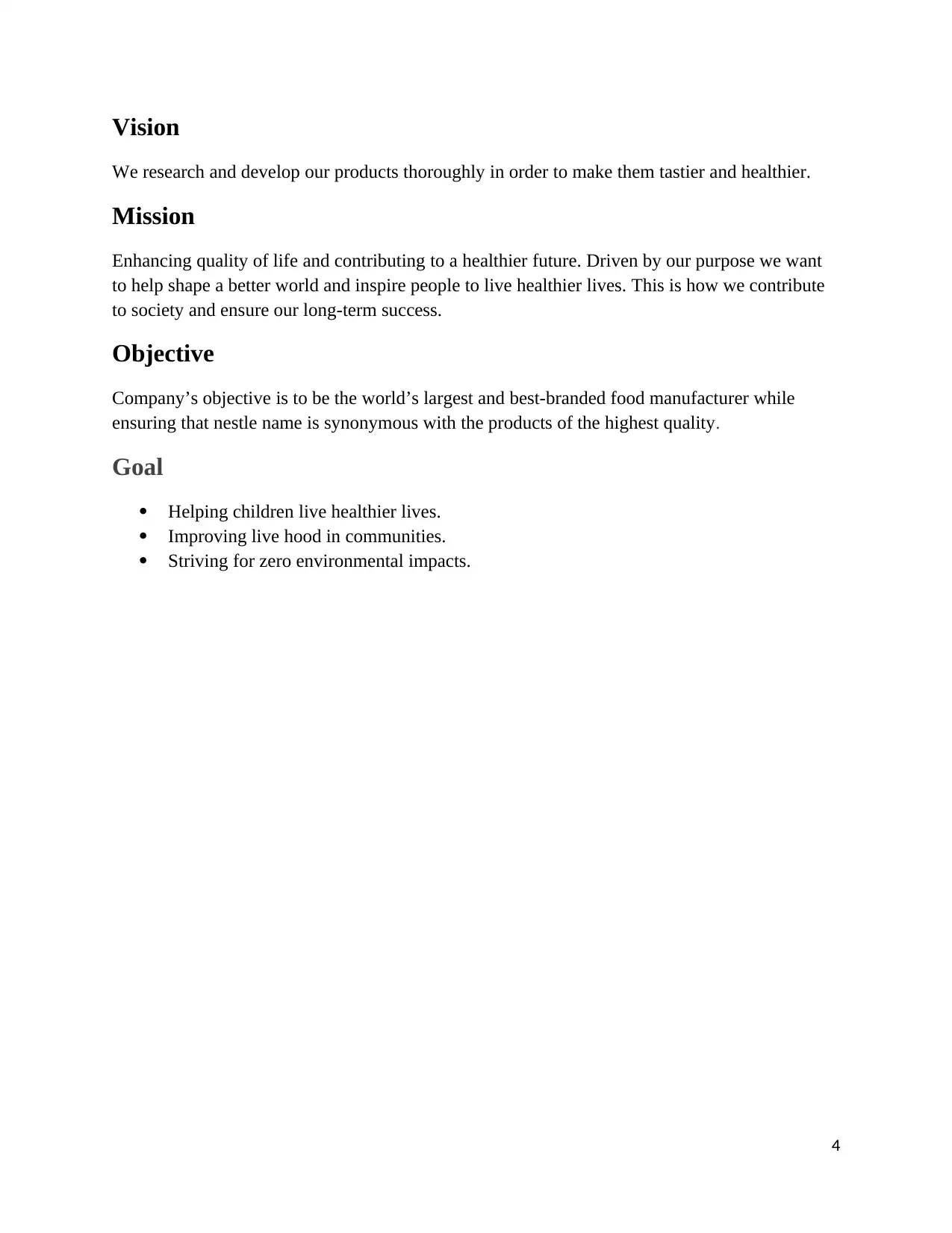
Vision
We research and develop our products thoroughly in order to make them tastier and healthier.
Mission
Enhancing quality of life and contributing to a healthier future. Driven by our purpose we want
to help shape a better world and inspire people to live healthier lives. This is how we contribute
to society and ensure our long-term success.
Objective
Company’s objective is to be the world’s largest and best-branded food manufacturer while
ensuring that nestle name is synonymous with the products of the highest quality.
Goal
Helping children live healthier lives.
Improving live hood in communities.
Striving for zero environmental impacts.
4
We research and develop our products thoroughly in order to make them tastier and healthier.
Mission
Enhancing quality of life and contributing to a healthier future. Driven by our purpose we want
to help shape a better world and inspire people to live healthier lives. This is how we contribute
to society and ensure our long-term success.
Objective
Company’s objective is to be the world’s largest and best-branded food manufacturer while
ensuring that nestle name is synonymous with the products of the highest quality.
Goal
Helping children live healthier lives.
Improving live hood in communities.
Striving for zero environmental impacts.
4
Paraphrase This Document
Need a fresh take? Get an instant paraphrase of this document with our AI Paraphraser
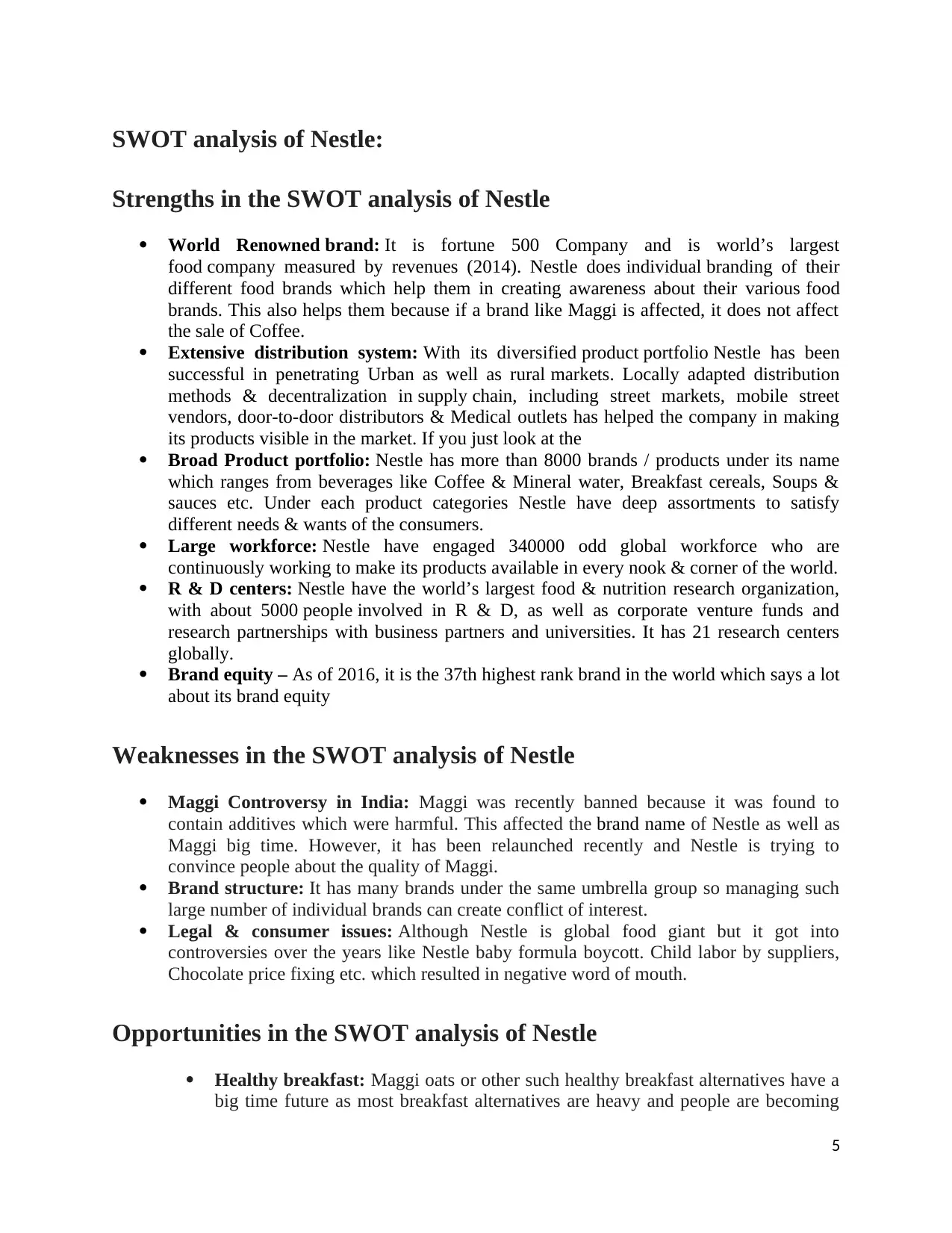
SWOT analysis of Nestle:
Strengths in the SWOT analysis of Nestle
World Renowned brand: It is fortune 500 Company and is world’s largest
food company measured by revenues (2014). Nestle does individual branding of their
different food brands which help them in creating awareness about their various food
brands. This also helps them because if a brand like Maggi is affected, it does not affect
the sale of Coffee.
Extensive distribution system: With its diversified product portfolio Nestle has been
successful in penetrating Urban as well as rural markets. Locally adapted distribution
methods & decentralization in supply chain, including street markets, mobile street
vendors, door-to-door distributors & Medical outlets has helped the company in making
its products visible in the market. If you just look at the
Broad Product portfolio: Nestle has more than 8000 brands / products under its name
which ranges from beverages like Coffee & Mineral water, Breakfast cereals, Soups &
sauces etc. Under each product categories Nestle have deep assortments to satisfy
different needs & wants of the consumers.
Large workforce: Nestle have engaged 340000 odd global workforce who are
continuously working to make its products available in every nook & corner of the world.
R & D centers: Nestle have the world’s largest food & nutrition research organization,
with about 5000 people involved in R & D, as well as corporate venture funds and
research partnerships with business partners and universities. It has 21 research centers
globally.
Brand equity – As of 2016, it is the 37th highest rank brand in the world which says a lot
about its brand equity
Weaknesses in the SWOT analysis of Nestle
Maggi Controversy in India: Maggi was recently banned because it was found to
contain additives which were harmful. This affected the brand name of Nestle as well as
Maggi big time. However, it has been relaunched recently and Nestle is trying to
convince people about the quality of Maggi.
Brand structure: It has many brands under the same umbrella group so managing such
large number of individual brands can create conflict of interest.
Legal & consumer issues: Although Nestle is global food giant but it got into
controversies over the years like Nestle baby formula boycott. Child labor by suppliers,
Chocolate price fixing etc. which resulted in negative word of mouth.
Opportunities in the SWOT analysis of Nestle
Healthy breakfast: Maggi oats or other such healthy breakfast alternatives have a
big time future as most breakfast alternatives are heavy and people are becoming
5
Strengths in the SWOT analysis of Nestle
World Renowned brand: It is fortune 500 Company and is world’s largest
food company measured by revenues (2014). Nestle does individual branding of their
different food brands which help them in creating awareness about their various food
brands. This also helps them because if a brand like Maggi is affected, it does not affect
the sale of Coffee.
Extensive distribution system: With its diversified product portfolio Nestle has been
successful in penetrating Urban as well as rural markets. Locally adapted distribution
methods & decentralization in supply chain, including street markets, mobile street
vendors, door-to-door distributors & Medical outlets has helped the company in making
its products visible in the market. If you just look at the
Broad Product portfolio: Nestle has more than 8000 brands / products under its name
which ranges from beverages like Coffee & Mineral water, Breakfast cereals, Soups &
sauces etc. Under each product categories Nestle have deep assortments to satisfy
different needs & wants of the consumers.
Large workforce: Nestle have engaged 340000 odd global workforce who are
continuously working to make its products available in every nook & corner of the world.
R & D centers: Nestle have the world’s largest food & nutrition research organization,
with about 5000 people involved in R & D, as well as corporate venture funds and
research partnerships with business partners and universities. It has 21 research centers
globally.
Brand equity – As of 2016, it is the 37th highest rank brand in the world which says a lot
about its brand equity
Weaknesses in the SWOT analysis of Nestle
Maggi Controversy in India: Maggi was recently banned because it was found to
contain additives which were harmful. This affected the brand name of Nestle as well as
Maggi big time. However, it has been relaunched recently and Nestle is trying to
convince people about the quality of Maggi.
Brand structure: It has many brands under the same umbrella group so managing such
large number of individual brands can create conflict of interest.
Legal & consumer issues: Although Nestle is global food giant but it got into
controversies over the years like Nestle baby formula boycott. Child labor by suppliers,
Chocolate price fixing etc. which resulted in negative word of mouth.
Opportunities in the SWOT analysis of Nestle
Healthy breakfast: Maggi oats or other such healthy breakfast alternatives have a
big time future as most breakfast alternatives are heavy and people are becoming
5
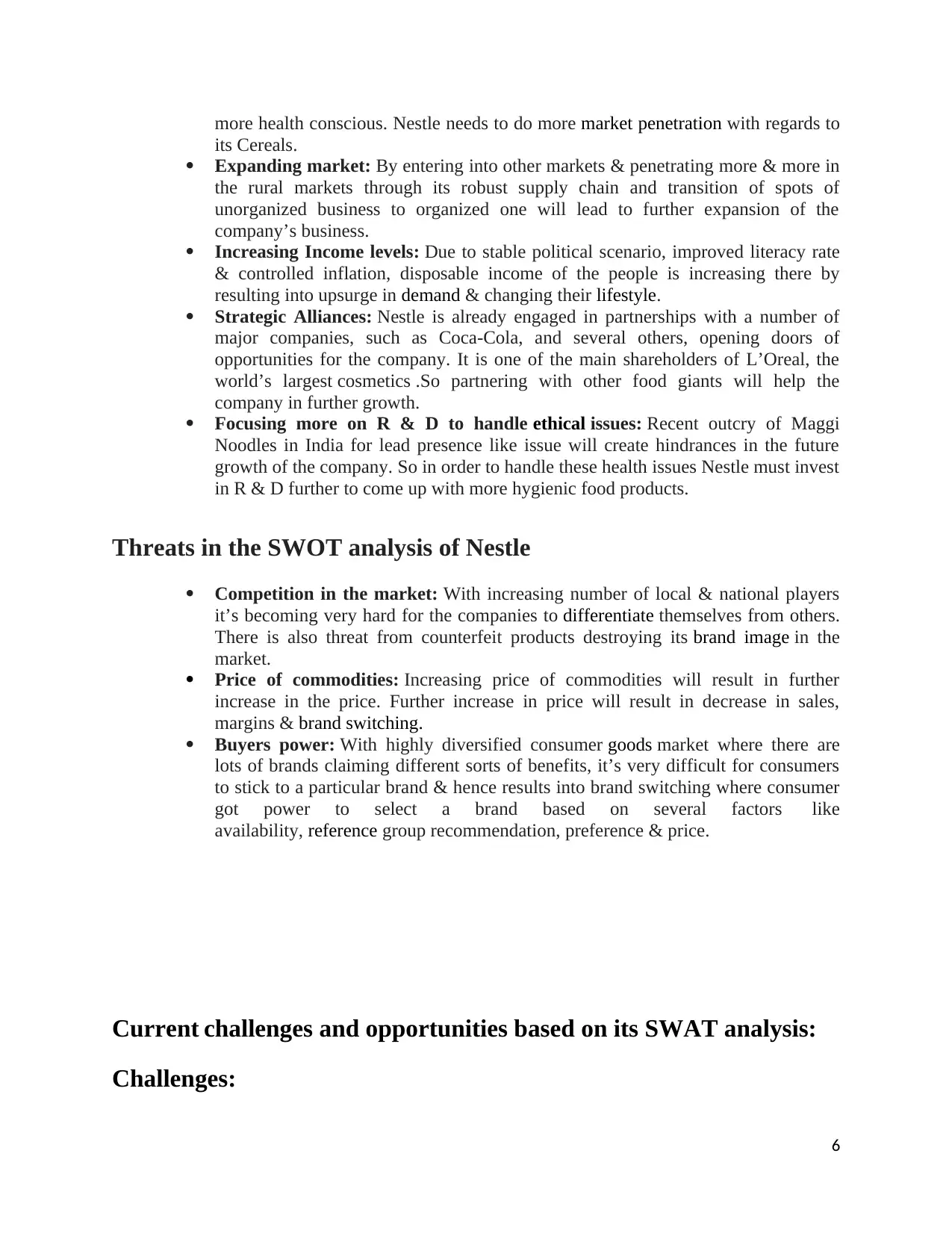
more health conscious. Nestle needs to do more market penetration with regards to
its Cereals.
Expanding market: By entering into other markets & penetrating more & more in
the rural markets through its robust supply chain and transition of spots of
unorganized business to organized one will lead to further expansion of the
company’s business.
Increasing Income levels: Due to stable political scenario, improved literacy rate
& controlled inflation, disposable income of the people is increasing there by
resulting into upsurge in demand & changing their lifestyle.
Strategic Alliances: Nestle is already engaged in partnerships with a number of
major companies, such as Coca-Cola, and several others, opening doors of
opportunities for the company. It is one of the main shareholders of L’Oreal, the
world’s largest cosmetics .So partnering with other food giants will help the
company in further growth.
Focusing more on R & D to handle ethical issues: Recent outcry of Maggi
Noodles in India for lead presence like issue will create hindrances in the future
growth of the company. So in order to handle these health issues Nestle must invest
in R & D further to come up with more hygienic food products.
Threats in the SWOT analysis of Nestle
Competition in the market: With increasing number of local & national players
it’s becoming very hard for the companies to differentiate themselves from others.
There is also threat from counterfeit products destroying its brand image in the
market.
Price of commodities: Increasing price of commodities will result in further
increase in the price. Further increase in price will result in decrease in sales,
margins & brand switching.
Buyers power: With highly diversified consumer goods market where there are
lots of brands claiming different sorts of benefits, it’s very difficult for consumers
to stick to a particular brand & hence results into brand switching where consumer
got power to select a brand based on several factors like
availability, reference group recommendation, preference & price.
Current challenges and opportunities based on its SWAT analysis:
Challenges:
6
its Cereals.
Expanding market: By entering into other markets & penetrating more & more in
the rural markets through its robust supply chain and transition of spots of
unorganized business to organized one will lead to further expansion of the
company’s business.
Increasing Income levels: Due to stable political scenario, improved literacy rate
& controlled inflation, disposable income of the people is increasing there by
resulting into upsurge in demand & changing their lifestyle.
Strategic Alliances: Nestle is already engaged in partnerships with a number of
major companies, such as Coca-Cola, and several others, opening doors of
opportunities for the company. It is one of the main shareholders of L’Oreal, the
world’s largest cosmetics .So partnering with other food giants will help the
company in further growth.
Focusing more on R & D to handle ethical issues: Recent outcry of Maggi
Noodles in India for lead presence like issue will create hindrances in the future
growth of the company. So in order to handle these health issues Nestle must invest
in R & D further to come up with more hygienic food products.
Threats in the SWOT analysis of Nestle
Competition in the market: With increasing number of local & national players
it’s becoming very hard for the companies to differentiate themselves from others.
There is also threat from counterfeit products destroying its brand image in the
market.
Price of commodities: Increasing price of commodities will result in further
increase in the price. Further increase in price will result in decrease in sales,
margins & brand switching.
Buyers power: With highly diversified consumer goods market where there are
lots of brands claiming different sorts of benefits, it’s very difficult for consumers
to stick to a particular brand & hence results into brand switching where consumer
got power to select a brand based on several factors like
availability, reference group recommendation, preference & price.
Current challenges and opportunities based on its SWAT analysis:
Challenges:
6
⊘ This is a preview!⊘
Do you want full access?
Subscribe today to unlock all pages.

Trusted by 1+ million students worldwide
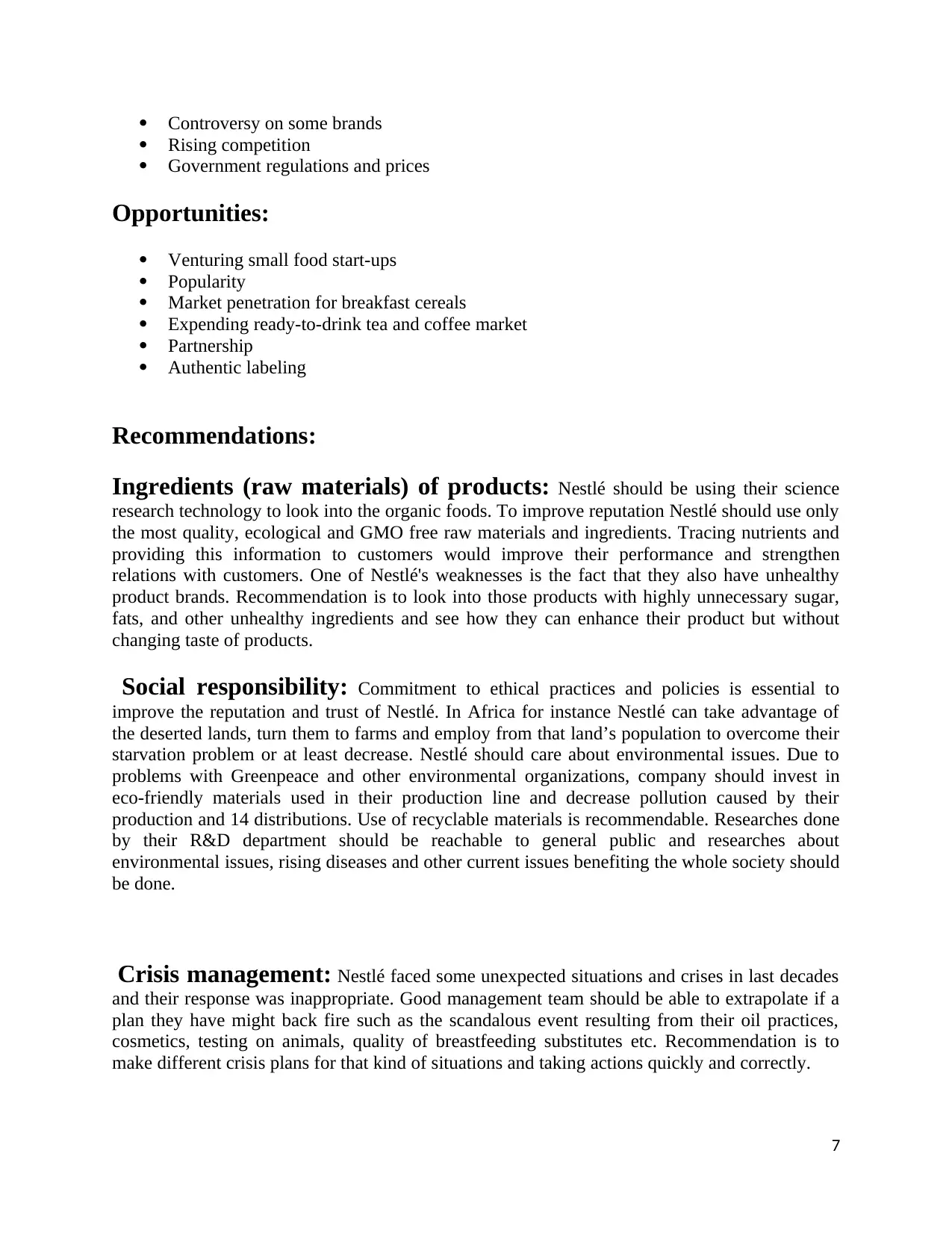
Controversy on some brands
Rising competition
Government regulations and prices
Opportunities:
Venturing small food start-ups
Popularity
Market penetration for breakfast cereals
Expending ready-to-drink tea and coffee market
Partnership
Authentic labeling
Recommendations:
Ingredients (raw materials) of products: Nestlé should be using their science
research technology to look into the organic foods. To improve reputation Nestlé should use only
the most quality, ecological and GMO free raw materials and ingredients. Tracing nutrients and
providing this information to customers would improve their performance and strengthen
relations with customers. One of Nestlé's weaknesses is the fact that they also have unhealthy
product brands. Recommendation is to look into those products with highly unnecessary sugar,
fats, and other unhealthy ingredients and see how they can enhance their product but without
changing taste of products.
Social responsibility: Commitment to ethical practices and policies is essential to
improve the reputation and trust of Nestlé. In Africa for instance Nestlé can take advantage of
the deserted lands, turn them to farms and employ from that land’s population to overcome their
starvation problem or at least decrease. Nestlé should care about environmental issues. Due to
problems with Greenpeace and other environmental organizations, company should invest in
eco-friendly materials used in their production line and decrease pollution caused by their
production and 14 distributions. Use of recyclable materials is recommendable. Researches done
by their R&D department should be reachable to general public and researches about
environmental issues, rising diseases and other current issues benefiting the whole society should
be done.
Crisis management: Nestlé faced some unexpected situations and crises in last decades
and their response was inappropriate. Good management team should be able to extrapolate if a
plan they have might back fire such as the scandalous event resulting from their oil practices,
cosmetics, testing on animals, quality of breastfeeding substitutes etc. Recommendation is to
make different crisis plans for that kind of situations and taking actions quickly and correctly.
7
Rising competition
Government regulations and prices
Opportunities:
Venturing small food start-ups
Popularity
Market penetration for breakfast cereals
Expending ready-to-drink tea and coffee market
Partnership
Authentic labeling
Recommendations:
Ingredients (raw materials) of products: Nestlé should be using their science
research technology to look into the organic foods. To improve reputation Nestlé should use only
the most quality, ecological and GMO free raw materials and ingredients. Tracing nutrients and
providing this information to customers would improve their performance and strengthen
relations with customers. One of Nestlé's weaknesses is the fact that they also have unhealthy
product brands. Recommendation is to look into those products with highly unnecessary sugar,
fats, and other unhealthy ingredients and see how they can enhance their product but without
changing taste of products.
Social responsibility: Commitment to ethical practices and policies is essential to
improve the reputation and trust of Nestlé. In Africa for instance Nestlé can take advantage of
the deserted lands, turn them to farms and employ from that land’s population to overcome their
starvation problem or at least decrease. Nestlé should care about environmental issues. Due to
problems with Greenpeace and other environmental organizations, company should invest in
eco-friendly materials used in their production line and decrease pollution caused by their
production and 14 distributions. Use of recyclable materials is recommendable. Researches done
by their R&D department should be reachable to general public and researches about
environmental issues, rising diseases and other current issues benefiting the whole society should
be done.
Crisis management: Nestlé faced some unexpected situations and crises in last decades
and their response was inappropriate. Good management team should be able to extrapolate if a
plan they have might back fire such as the scandalous event resulting from their oil practices,
cosmetics, testing on animals, quality of breastfeeding substitutes etc. Recommendation is to
make different crisis plans for that kind of situations and taking actions quickly and correctly.
7
Paraphrase This Document
Need a fresh take? Get an instant paraphrase of this document with our AI Paraphraser
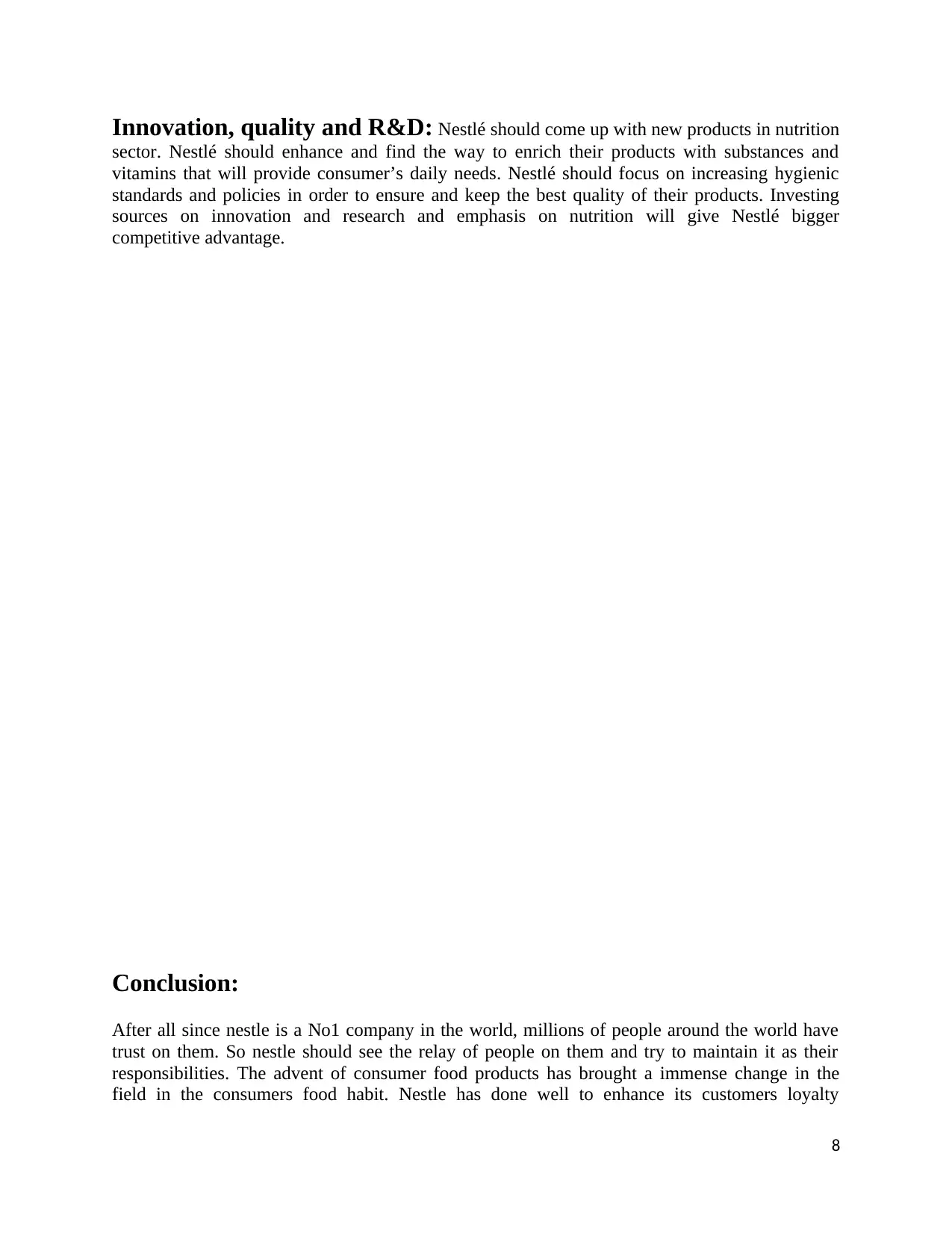
Innovation, quality and R&D: Nestlé should come up with new products in nutrition
sector. Nestlé should enhance and find the way to enrich their products with substances and
vitamins that will provide consumer’s daily needs. Nestlé should focus on increasing hygienic
standards and policies in order to ensure and keep the best quality of their products. Investing
sources on innovation and research and emphasis on nutrition will give Nestlé bigger
competitive advantage.
Conclusion:
After all since nestle is a No1 company in the world, millions of people around the world have
trust on them. So nestle should see the relay of people on them and try to maintain it as their
responsibilities. The advent of consumer food products has brought a immense change in the
field in the consumers food habit. Nestle has done well to enhance its customers loyalty
8
sector. Nestlé should enhance and find the way to enrich their products with substances and
vitamins that will provide consumer’s daily needs. Nestlé should focus on increasing hygienic
standards and policies in order to ensure and keep the best quality of their products. Investing
sources on innovation and research and emphasis on nutrition will give Nestlé bigger
competitive advantage.
Conclusion:
After all since nestle is a No1 company in the world, millions of people around the world have
trust on them. So nestle should see the relay of people on them and try to maintain it as their
responsibilities. The advent of consumer food products has brought a immense change in the
field in the consumers food habit. Nestle has done well to enhance its customers loyalty
8
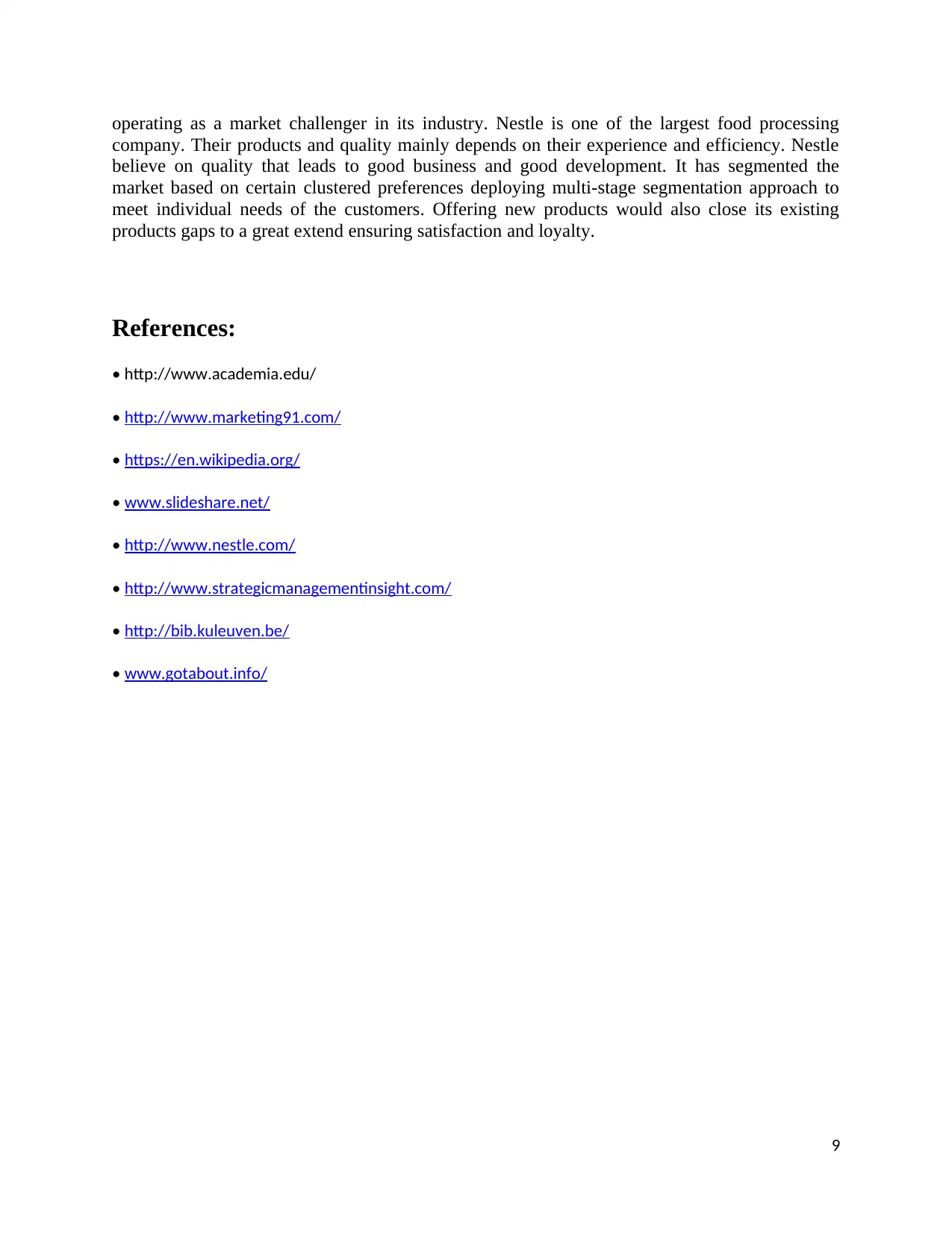
operating as a market challenger in its industry. Nestle is one of the largest food processing
company. Their products and quality mainly depends on their experience and efficiency. Nestle
believe on quality that leads to good business and good development. It has segmented the
market based on certain clustered preferences deploying multi-stage segmentation approach to
meet individual needs of the customers. Offering new products would also close its existing
products gaps to a great extend ensuring satisfaction and loyalty.
References:
• http://www.academia.edu/
• http://www.marketing91.com/
• https://en.wikipedia.org/
• www.slideshare.net/
• http://www.nestle.com/
• http://www.strategicmanagementinsight.com/
• http://bib.kuleuven.be/
• www.gotabout.info/
9
company. Their products and quality mainly depends on their experience and efficiency. Nestle
believe on quality that leads to good business and good development. It has segmented the
market based on certain clustered preferences deploying multi-stage segmentation approach to
meet individual needs of the customers. Offering new products would also close its existing
products gaps to a great extend ensuring satisfaction and loyalty.
References:
• http://www.academia.edu/
• http://www.marketing91.com/
• https://en.wikipedia.org/
• www.slideshare.net/
• http://www.nestle.com/
• http://www.strategicmanagementinsight.com/
• http://bib.kuleuven.be/
• www.gotabout.info/
9
⊘ This is a preview!⊘
Do you want full access?
Subscribe today to unlock all pages.

Trusted by 1+ million students worldwide
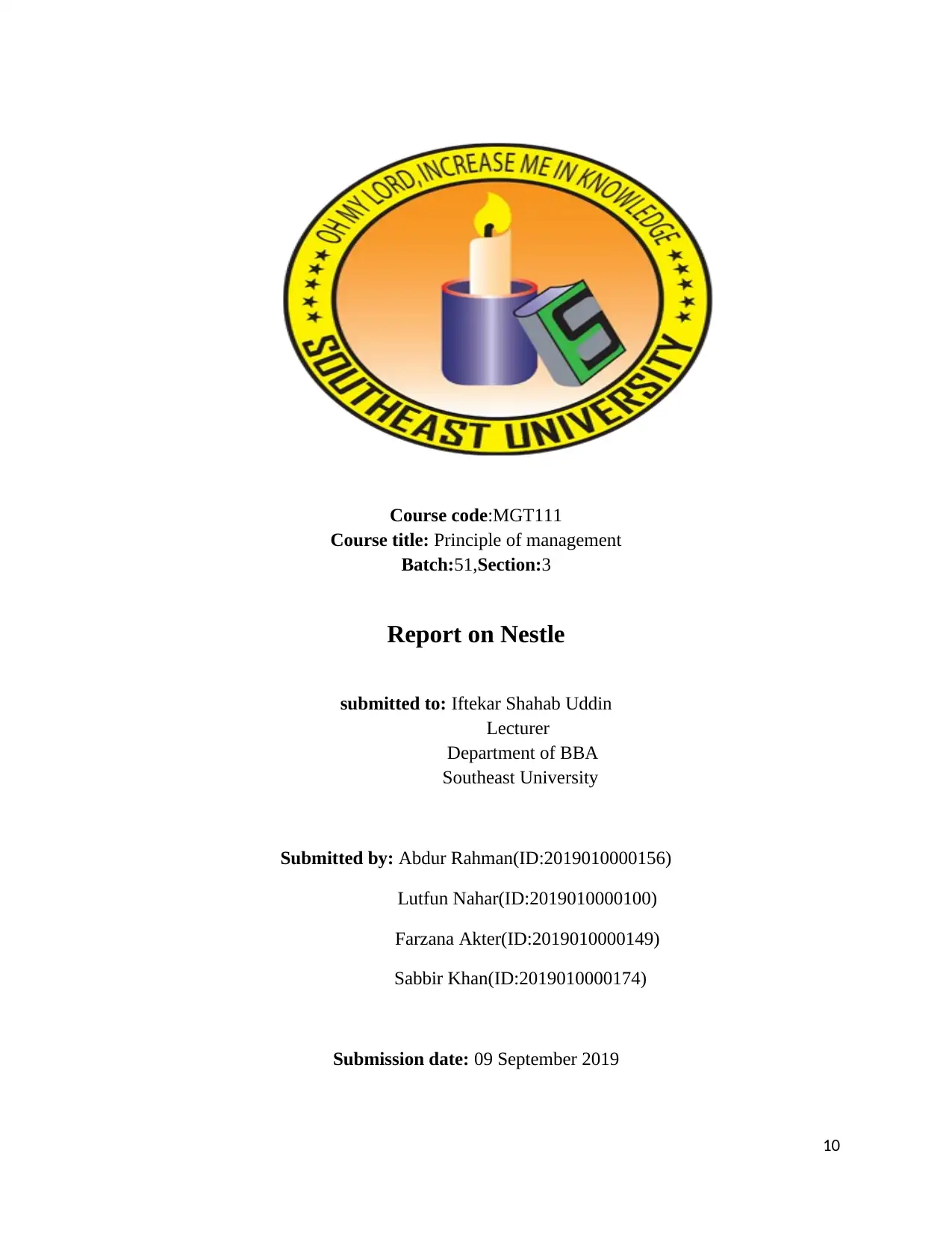
Course code:MGT111
Course title: Principle of management
Batch:51,Section:3
Report on Nestle
submitted to: Iftekar Shahab Uddin
Lecturer
Department of BBA
Southeast University
Submitted by: Abdur Rahman(ID:2019010000156)
Lutfun Nahar(ID:2019010000100)
Farzana Akter(ID:2019010000149)
Sabbir Khan(ID:2019010000174)
Submission date: 09 September 2019
10
Course title: Principle of management
Batch:51,Section:3
Report on Nestle
submitted to: Iftekar Shahab Uddin
Lecturer
Department of BBA
Southeast University
Submitted by: Abdur Rahman(ID:2019010000156)
Lutfun Nahar(ID:2019010000100)
Farzana Akter(ID:2019010000149)
Sabbir Khan(ID:2019010000174)
Submission date: 09 September 2019
10
Paraphrase This Document
Need a fresh take? Get an instant paraphrase of this document with our AI Paraphraser
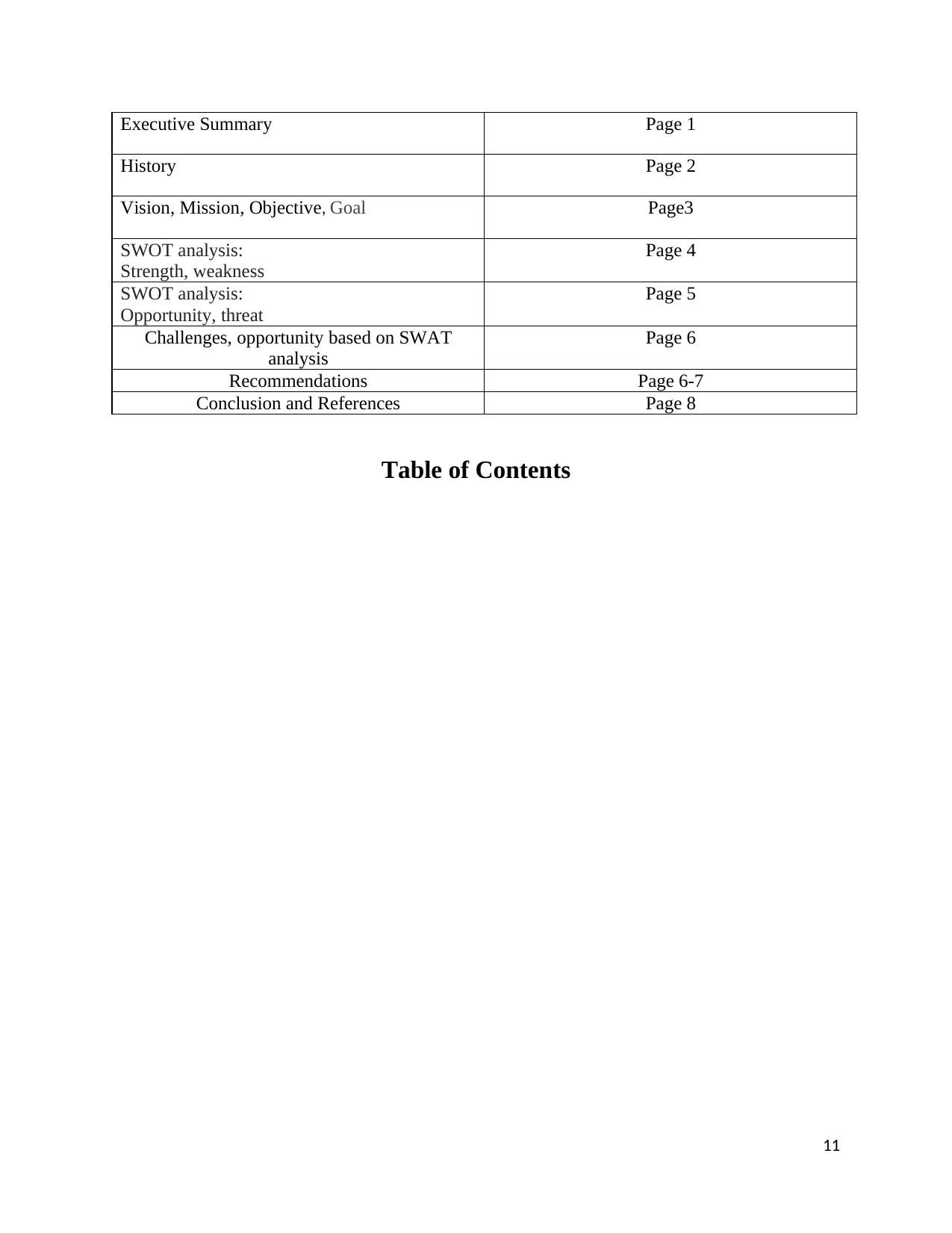
Executive Summary Page 1
History Page 2
Vision, Mission, Objective, Goal Page3
SWOT analysis:
Strength, weakness
Page 4
SWOT analysis:
Opportunity, threat
Page 5
Challenges, opportunity based on SWAT
analysis
Page 6
Recommendations Page 6-7
Conclusion and References Page 8
Table of Contents
11
History Page 2
Vision, Mission, Objective, Goal Page3
SWOT analysis:
Strength, weakness
Page 4
SWOT analysis:
Opportunity, threat
Page 5
Challenges, opportunity based on SWAT
analysis
Page 6
Recommendations Page 6-7
Conclusion and References Page 8
Table of Contents
11
1 out of 11
Related Documents
Your All-in-One AI-Powered Toolkit for Academic Success.
+13062052269
info@desklib.com
Available 24*7 on WhatsApp / Email
![[object Object]](/_next/static/media/star-bottom.7253800d.svg)
Unlock your academic potential
Copyright © 2020–2025 A2Z Services. All Rights Reserved. Developed and managed by ZUCOL.





